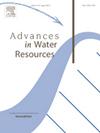Spatial variations of velocity and pressure fields induced by large-scale (single stalk) and small-scale (sediment) roughness elements
IF 4.2
2区 环境科学与生态学
Q1 WATER RESOURCES
引用次数: 0
Abstract
Characterizing velocity and pressure fields in aquatic systems is crucial for understanding fundamental processes such as sediment transport, hyporheic flow, air-water exchange, and habitat quality. While large obstacles like vegetation stalks are known to create significant localized pressure gradients, the role of small-scale bed roughness in generating local pressure gradients remains poorly understood. Here, we explore flow dynamics around a vertical cylinder (simulating vegetation) over a coarse granular bed using stereo particle image velocimetry (SPIV) with refractive index-matched (RIM) fluid, integrated with Large Eddy Simulations (LES). Our combined approach reveals an important phenomenon: while large obstacles like vegetation stalks create localized pressure gradients, bed roughness elements generate frequent pressure fluctuations across the entire streambed. Although previous studies have focused primarily on large-obstacle effects, our findings show that grain-scale pressure variations generate stronger local gradients (up to ±250 mmH₂O/m) than those from large obstacles (±50 mmH₂O/m), and their widespread occurrence throughout the bed surface may collectively have substantial effects on hyporheic exchange. By quantifying pressure fields at both large and small scales, we demonstrate that bed roughness elements create persistent pressure gradients that, due to their widespread occurrence, may significantly influence surface-subsurface water interactions. Our results highlight the importance of considering grain-scale roughness effects when studying hyporheic processes in natural streams.
大尺度(单茎)和小尺度(泥沙)粗糙度因素引起的速度和压力场的空间变化
表征水生系统中的速度和压力场对于理解沉积物运输、潜流、空气-水交换和栖息地质量等基本过程至关重要。虽然已知像植被秸秆这样的大型障碍物会产生显著的局部压力梯度,但小规模床层粗糙度在产生局部压力梯度中的作用仍然知之甚少。在这里,我们使用具有折射率匹配(RIM)流体的立体粒子图像测速(SPIV),结合大涡模拟(LES),探索了粗颗粒床上垂直圆柱体(模拟植被)周围的流动动力学。我们的联合方法揭示了一个重要的现象:虽然植被秸秆等大型障碍物会产生局部压力梯度,但河床粗糙度因素会在整个河床上产生频繁的压力波动。虽然以前的研究主要集中在大障碍效应上,但我们的研究结果表明,颗粒尺度的压力变化产生的局部梯度(高达±250 mmH₂O/m)比大障碍(±50 mmH₂O/m)产生的梯度更强,它们在整个床表面的广泛存在可能共同对低循环交换产生重大影响。通过对大尺度和小尺度的压力场进行量化,我们证明了河床粗糙度元素会产生持续的压力梯度,由于它们的广泛存在,可能会显著影响地表-地下水的相互作用。我们的研究结果强调了在研究自然溪流的潜流过程时考虑粒度粗糙度效应的重要性。
本文章由计算机程序翻译,如有差异,请以英文原文为准。
求助全文
约1分钟内获得全文
求助全文
来源期刊

Advances in Water Resources
环境科学-水资源
CiteScore
9.40
自引率
6.40%
发文量
171
审稿时长
36 days
期刊介绍:
Advances in Water Resources provides a forum for the presentation of fundamental scientific advances in the understanding of water resources systems. The scope of Advances in Water Resources includes any combination of theoretical, computational, and experimental approaches used to advance fundamental understanding of surface or subsurface water resources systems or the interaction of these systems with the atmosphere, geosphere, biosphere, and human societies. Manuscripts involving case studies that do not attempt to reach broader conclusions, research on engineering design, applied hydraulics, or water quality and treatment, as well as applications of existing knowledge that do not advance fundamental understanding of hydrological processes, are not appropriate for Advances in Water Resources.
Examples of appropriate topical areas that will be considered include the following:
• Surface and subsurface hydrology
• Hydrometeorology
• Environmental fluid dynamics
• Ecohydrology and ecohydrodynamics
• Multiphase transport phenomena in porous media
• Fluid flow and species transport and reaction processes
 求助内容:
求助内容: 应助结果提醒方式:
应助结果提醒方式:


